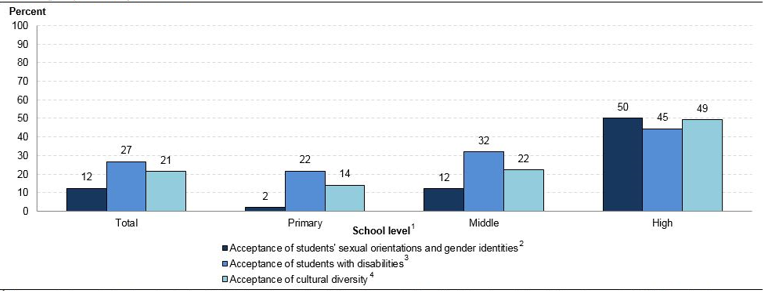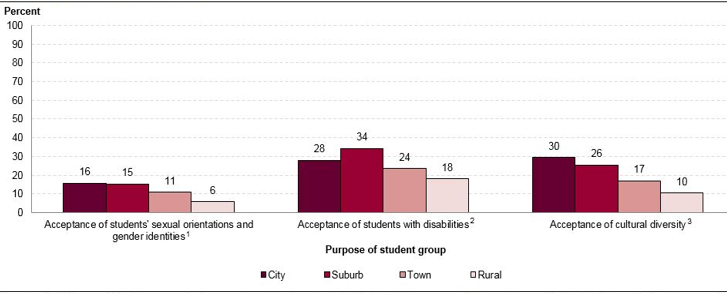Schools can help to foster students’ understanding of diversity and create environments where students feel safe and welcome. One way to do this is by organizing student groups whose purpose is to promote acceptance of other students. The School Survey on Crime and Safety (SSOCS) collected data on the presence of recognized student acceptance groups during the 2015–16 school year from a nationally representative sample of 3,500 K–12 public schools. The questionnaire asked whether schools had student groups that promote acceptance of students’ sexual orientations[i] and gender identities,[ii] of students with disabilities, and of cultural diversity.
Among all public schools, groups that promote acceptance of students with disabilities were most common. Some 27 percent of schools reported having a student group that promotes acceptance of students with disabilities during the 2015–16 school year, compared with 21 percent that reported having a student group that promotes acceptance of cultural diversity and 12 percent that reported having a student group that promotes acceptance of students’ sexual orientations and gender identities.
Figure 1. Percentage of public schools reporting the presence of recognized student acceptance groups, by school level and purpose of student group: School year 2015–16

1Primary schools are defined as schools in which the lowest grade is not higher than grade 3 and the highest grade is not higher than grade 8. Middle schools are defined as schools in which the lowest grade is not lower than grade 4 and the highest grade is not higher than grade 9. High schools are defined as schools in which the lowest grade is not lower than grade 9 and the highest grade is not higher than grade 12. The total also includes combined schools. Combined schools are schools that have a combination of grades that cannot be categorized as primary, middle, or high schools, including K–12 schools.
2Sexual orientation was defined for respondents as one’s emotional or physical attraction to the same and/or opposite sex. Gender identity was defined for respondents as one’s inner sense of one’s own gender, which may or may not match the sex assigned at birth. Different people choose to express their gender identity differently. For some, gender may be expressed through, for example, dress, grooming, mannerisms, speech patterns, and social interactions. Gender expression usually ranges between masculine and feminine, and some transgender people express their gender consistent with how they identify internally, rather than in accordance with the sex they were assigned at birth. An example of a student group to promote acceptance of students' sexual orientations and gender identities provided to respondents was a Gay-Straight Alliance.
3An example of a student group to promote acceptance of students with disabilities provided to respondents was Best Buddies.
4An example of a student group to promote acceptance of cultural diversity provided to respondents was a Cultural Awareness Club.
NOTE: Responses were provided by the principal or the person most knowledgeable about school crime and policies to provide a safe environment. Although rounded numbers are displayed, the figures are based on unrounded data.
SOURCE: U.S. Department of Education, National Center for Education Statistics (NCES), 2015–16 School Survey on Crime and Safety (SSOCS), 2016. See table 37.
All three types of acceptance groups were more common in high schools than in middle or primary schools. The most common type of student acceptance group varied by school level. For example, among middle schools, the percentage of schools that reported having a student group that promotes acceptance of students with disabilities (32 percent) was higher than the percentage that reported having a student group that promotes acceptance of cultural diversity (22 percent) or acceptance of students’ sexual orientations and gender identities (12 percent). This pattern was similar for primary schools. Among high schools, the percentage of schools that reported having a student group that promotes acceptance of students’ sexual orientations and gender identities (50 percent) was higher than the percentage that reported having a student group that promotes acceptance of students with disabilities (45 percent).
During the 2015–16 school year, all three types of student acceptance groups were more commonly found in schools in cities and suburbs than in schools in rural areas. For example, 30 percent of schools in cities and 26 percent of schools in suburbs reported having a student group that promotes acceptance of cultural diversity, compared with 10 percent of schools in rural areas.
Figure 2. Percentage of public schools reporting the presence of recognized student acceptance groups, by purpose of student group and school locale: School year 2015–16

1Sexual orientation was defined for respondents as one's emotional or physical attraction to the same and/or opposite sex. Gender identity was defined for respondents as one's inner sense of one's own gender, which may or may not match the sex assigned at birth. Different people choose to express their gender identity differently. For some, gender may be expressed through, for example, dress, grooming, mannerisms, speech patterns, and social interactions. Gender expression usually ranges between masculine and feminine, and some transgender people express their gender consistent with how they identify internally, rather than in accordance with the sex they were assigned at birth. An example of a student group to promote acceptance of students' sexual orientations and gender identities provided to respondents was a Gay-Straight Alliance.
2An example of a student group to promote acceptance of students with disabilities provided to respondents was Best Buddies.
3An example of a student group to promote acceptance of cultural diversity provided to respondents was a Cultural Awareness Club.
NOTE: Responses were provided by the principal or the person most knowledgeable about school crime and policies to provide a safe environment.
SOURCE: U.S. Department of Education, National Center for Education Statistics (NCES), 2015–16 School Survey on Crime and Safety (SSOCS), 2016. See table 37.
You can find more information on school crime and safety in NCES publications, including Crime, Violence, Discipline, and Safety in U.S. Public Schools: Findings From the School Survey on Crime and Safety: 2015–16 and the 2017 Indicators of School Crime and Safety.
By Rachel Hansen, NCES, and Melissa Diliberti, AIR
[i]Sexual orientation was defined for respondents as one’s emotional or physical attraction to the same and/or opposite sex.
[ii]Gender identity was defined for respondents as one’s inner sense of one’s own gender, which may or may not match the sex assigned at birth. Different people choose to express their gender identity differently. For some, gender may be expressed through, for example, dress, grooming, mannerisms, speech patterns, and social interactions. Gender expression usually ranges between masculine and feminine, and some transgender people express their gender consistent with how they identify internally, rather than in accordance with the sex they were assigned at birth.